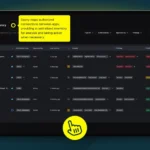The recent Change Healthcare breach serves as a stark reminder of the critical role that authentication and access management, as well as application security, play in safeguarding sensitive data and systems. Recent reports suggest hackers compromised credentials for a SaaS app and MFA wasn’t enabled on the account. The absence of multi-factor authentication allegedly left a remote access application exposed and vulnerable to credential compromise. Cybercriminals subsequently loitered on the US health provider’s systems for nine days before stealing data and launching a ransomware attack.
The rise of SaaS security incidents due to compromised credentials and lack of MFA
Software as a Service (SaaS) applications have become indispensable tools for organizations, offering convenience, scalability, and flexibility. However, amidst this convenience lies a significant risk—having inadequate or no visibility into the SaaS applications in your environment, particularly those without Multi-factor Authentication (MFA) or harboring weak passwords.
Recent data from The Annual SaaS Security Survey Report of 2024 reveals that 55% of organizations encountered at least one SaaS security incident within the past two years, while an additional 12% remain unsure of their exposure. These figures serve as a wake-up call to companies, highlighting the sobering reality that attacks like ransomware, malware, and data breaches will increasingly originate from SaaS environments, mirroring many threats aimed at traditional on-premises systems.
However, despite the mounting security challenges, current SaaS security strategies and methodologies fall short. Surprisingly, over half (58%) of organizations estimate that their existing SaaS security solutions only cover 50% or less of their SaaS applications. It has become increasingly apparent that manual audits and Cloud Access Security Brokers (CASBs) are no longer sufficient in safeguarding organizations against SaaS security incidents.
Although organizations leverage a combination of Identity and Access Management (IAM) solutions to address these challenges, these solutions often have blind spots when it comes to providing comprehensive visibility into SaaS application security. This lack of visibility exposes organizations to potential security breaches, leaving sensitive data and critical systems vulnerable to unauthorized access.
The hidden challenges and blind spots of SaaS-identity security
The Shadow of Unidentified SaaS Apps
Within the sprawling ecosystem of organizational IT infrastructure, shadow IT lurks, often comprised of unauthorized or unidentified applications deployed by employees without explicit approval from IT departments. These rogue SaaS apps, while intended to enhance productivity, can inadvertently expose organizations to a myriad of security vulnerabilities.
MFA Absence and Misconfiguration: A Breach Waiting to Happen
One of the most critical security measures, MFA adds a layer of protection that operates as a secondary failsafe, requiring users to present multiple forms of identification before accessing sensitive data or resources. However, in the absence of proper oversight, unidentified or even managed SaaS applications lacking MFA become prime targets for malicious actors seeking to exploit vulnerabilities and gain unauthorized access.
The Peril of Weak Passwords
Weak passwords serve as low-hanging fruit for cybercriminals, providing an easy entry point into organizational networks and systems. SaaS apps with lax password policies pose a significant threat, as they offer little resistance against brute-force attacks and credential-stuffing tactics. Without robust password management policies and comprehensive visibility into the expanse of unmanaged apps, it is impossible to proactively identify these vulnerabilities and prompt users to change passwords that have been compromised in breaches or leaks.
The Consequences of Invisibility
The inability to identify SaaS applications lacking MFA or harboring weak passwords has far-reaching consequences, including:
- Data Breaches: Unprotected applications serve as gateways for unauthorized access, leading to data breaches and compromise of sensitive information.
- Compliance Violations: Non-compliance with industry regulations and standards, such as GDPR and HIPAA, exposes organizations to hefty fines and reputational damage.
- Reputational Damage: Security incidents erode trust and confidence among customers, partners, and stakeholders, tarnishing the organization’s reputation.
- Financial Loss: The fallout from security breaches, including remediation costs, legal fees, and loss of revenue, exacts a heavy financial toll on organizations.
Mitigating the Risks: The Savvy Identity Security Proactive Approach
To mitigate the security risks associated with managed or unmanaged SaaS apps lacking MFA or weak passwords, Savvy’s identity-security approach enables organizations to:
- Discover and Detect: The first step in Savvy’s approach is the discovery phase, uncovering the full spectrum of SaaS applications and their associated identities, whether sanctioned by IT or acquired through business-led actions. It creates this visibility by combining telemetry from the browser, email, and IdP, with each contributing to a more complete picture, allowing the organizations to identify potential security risks and areas where compliance may be jeopardized. Savvy’s multi-faceted detection unveils the full extent of your SaaS ecosystem, ensuring that no applications go unnoticed or unmonitored.
- Policy Enforcement: Through the use of no-code automated playbooks, Savvy allows organizations to enforce robust security policies mandating the use of MFA and enforcing strong password requirements across all SaaS applications.
- Continuous Monitoring: With Savvy, organizations can continuously monitor and audit SaaS apps to detect and remediate security gaps promptly. Dashboards help you identify IdP misconfigurations that allow users to disable or bypass MFA, as well as log in directly to an application versus using SSO where MFA is properly enforced.
- Automated Guidance – Savvy provides actionable insights that go beyond just detection and assessment. Users receive guidance based on previously established policies to minimize the risk of unauthorized or unmonitored SaaS app use. The platform actively educates and guides your team members in the responsible and compliant usage of SaaS apps. With a more proactive approach to SaaS security, you’ll have comprehensive policies at your disposal to reduce the likelihood of future Shadow IT risks and ensure complete compliance with industry standards.
- Enhance productivity – At Savvy, we believe in taking a human-centric approach, empowering your team with all the knowledge and tools needed to make smarter security decisions. For example, our proactive model for detecting AI and ensuring a policy compliance approach ensures that your benefits extend far beyond a security solution, allowing you to shape a culture of innovation that keeps you ahead of the competition.
The Change Healthcare breach serves as a timely reminder of the urgent need for robust security measures and expanding visibility into your SaaS ecosystem to proactively address security blind spots. Savvy’s monitoring and detection capabilities give you real-time visibility and insights into their SaaS app environment regardless of if they are federated or unfederated, including visibility into the presence of MFA and password strength, offering actionable insights and a complete picture of vulnerabilities. Our solution actively guides users in securing your organization’s data by offering comprehensive policies and best practices. We educate your team on the potential risks associated with SaaS app security and empower them to implement responsible usage measures.
Savvy Security: Improve MFA Coverage across your organization
Savvy helps organizations gain visibility and control of their SaaS environments. Using a sophisticated, identity-first approach, Savvy helps organizations understand the entire SaaS landscape, as well as authentication methods (e.g. SSO or direct login) and whether MFA is enabled. It the automates the enabling of MFA by enacting browser-based security guardrails to interact with users in realtime–improving compliance with MFA requirements. Savvy gives organizations the power to better manage their SaaS identities while aligning SaaS security with the rest of their operations.
Learn how Savvy can transform your organization’s approach to SaaS identity security, read our CyberRisk Alliance Research Report.
Frequently Asked Questions about MFA Coverage
1. How can we improve MFA coverage across all corporate applications?
To strengthen MFA coverage, start with a complete audit of all corporate applications using a discovery tool like the Savvy Security platform, to identify and prioritize which ones lack multi-factor authentication (MFA) enforcement. Use an identity provider (IdP) or single sign-on (SSO) solution to centralize authentication and require MFA for all logins. Enforce conditional access policies to ensure MFA is always used, even for legacy or on-premises apps. Regularly update your security policies to cover new applications and access points.
2. How do we validate MFA coverage and ensure it’s properly enforced?
Validating MFA coverage requires monitoring authentication logs and security reports from your identity provider and comparing that with observed behavior using a tool like the Savvy Security platform to provide browser-level visibility. Look for users who haven’t enrolled in MFA or are using outdated authentication methods. Conduct MFA audits to identify gaps, such as applications or user groups bypassing MFA. Implement automated security guardrails to guide users in realtime to keep MFA enabled and in compliance, ensuring that MFA is actively preventing unauthorized access.
3. What’s the best way to improve user adoption and compliance with MFA?
Boosting MFA adoption starts with user-friendly authentication methods like push notifications, biometric logins, or hardware tokens instead of SMS codes. Provide clear, step-by-step setup guides and just-in-time MFA training using browser-based security guardrails to minimize friction. Automate reminders for users who haven’t enabled MFA and integrate MFA into onboarding workflows to ensure full MFA coverage from day one.
By improving and validating MFA coverage, organizations can significantly reduce the risk of unauthorized access and strengthen their security posture.


